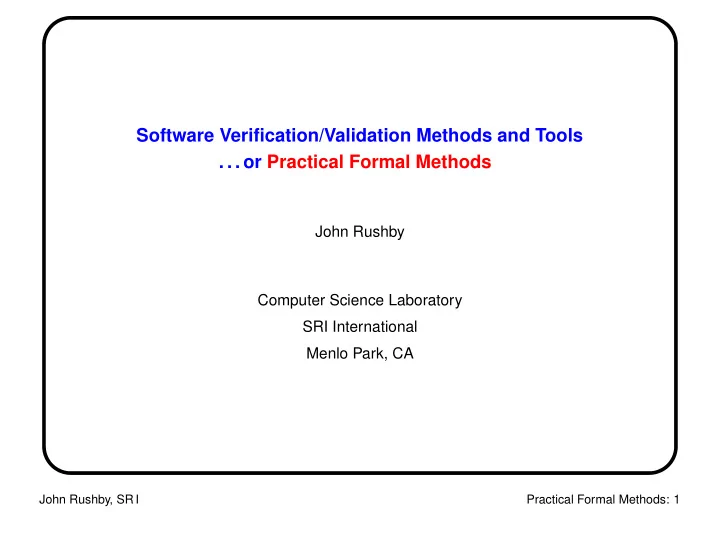

Software Verification/Validation Methods and Tools . . . or Practical Formal Methods John Rushby Computer Science Laboratory SRI International Menlo Park, CA John Rushby, SR I Practical Formal Methods: 1
Need: Growing Importance and Cost of Embedded Software • Most of the innovation in new cars is enabled by embedded software • There is more software in individual functions • But the big gains come from integration across functions • Integrated, distributed systems are hard to get right ◦ Especially if they have to be fault tolerant ◦ Or are safety-critical • So it is common for more than 75% of embedded softweare development costs to go into verification and verification • There is an opportunity to reduce costs and improve quality by applying automation to verification and verification of embedded systems John Rushby, SR I Practical Formal Methods: 2
Approach: Formal Methods • The basic idea is to use symbolic calculation to provide cheaper and better methods of verification and validation for software and systems • A single symbolic calculation can subsume many individual numeric cases ◦ Just as x 2 − y 2 = ( x − y ) × ( x + y ) ◦ Subsumes 36 − 16 = 2 × 10 and 49 − 4 = 5 × 9 and . . . • Can be used to find rare error scenarios as well as to verify their absence • Symbolic calculation is mechanized using the methods of automated reasoning: theorem proving, model checking, constraint solving, etc. • There has been sustained progress in these fields for several decades and they have recently broken through the barriers to practical application • SRI has been a leader of this technology throughout its history John Rushby, SR I Practical Formal Methods: 3
A Spectrum of Formal Methods Interactive theorem proving: requires great skill and resources • Can solve very hard problems • E.g., Verify that Flexray’s clock synchronization withstands any single fault Model checking: analysis is automatic but must specify the model and property • Can search huge state spaces (trillions of reachable states) efficiently • E.g., Find the worst case start up delay for Flexray • E.g., Check that horizontally integrated functions interact as expected Invisible formal methods: driven directly off model-based developments • Uses symbolic calculation to automate traditional work flows • E.g., Generate unit test cases to provide MC/DC coverage • E.g., “Find me an input vector that gets me to here with x > 3 ” • Check compliance with guidelines (e.g., no 12 o’clock rule in Stateflow) John Rushby, SR I Practical Formal Methods: 4
Our Tools Cover the Spectrum PVS Assurance SAL ICS theorem automated model proving checking abstraction invisible formal methods Effort John Rushby, SR I Practical Formal Methods: 5
Our Tools • PVS: Industrial strength theorem prover (since 1993) ◦ Probably the most widely used theorem prover in research and education ◦ Used for verification of AAMP5 (Rockwell) ◦ And Time Triggered Architecture (TTTech, NASA, Honeywell) ◦ GM group in Asia has recently applied for a license ◦ Some other commercial users (e.g., Sun) • SAL: Industrial strength suite of model checkers (since 2003) ◦ Used for analysis of TTA startup ◦ A current application focus is automated test generation • ICS: Core decision procedures and SAT solver used in PVS and SAL ◦ Designed to be embedded in other tools • See fm.csl.sri.com for descriptions and our roadmap John Rushby, SR I Practical Formal Methods: 6
Invisible Formal Methods • New design practices: model-based development methods provide the artifacts needed by automated analysis ◦ Models serve as formal specifications ◦ We have a formal semantics and translator for Stateflow • New technology (in SAL): very fast, scalable model checkers that can handle arithmetic and other data types • New ideas: invisible formal methods • These combine to create new opportunities • Example: Generate test vectors that will drive an implementation through all the states and transitions of its model John Rushby, SR I Practical Formal Methods: 7
Automated Test Case Generation • Basic approach uses the counterexamples generated by a model checker • Counterexample to you cannot get here is a test case that gets you there • There are several technical issues dealing with arithmetic in specifications ◦ Which we have solved (patents pending) • Existing methods give many short tests with much redundancy ◦ We have new methods that generate fewer deeper tests (patent pending) ◦ E.g., State coverage for a 4-speed shift selector in one test of length 86 • We also have technology (automated analysis of hybrid systems) that could take test test generation beyond unit tests into integration and system tests John Rushby, SR I Practical Formal Methods: 8
Benefits: Simplified Vee Diagram time and money system requirements test unit/integration design/code test Automated formal analysis can tighten the vee John Rushby, SR I Practical Formal Methods: 9
Tightened Vee Diagram time and money system requirements test unit/integration design/code test John Rushby, SR I Practical Formal Methods: 10
Competition • Test generation for Statemate is automated by Motorola in Veristate ◦ Good integration, relies on user-written “test observers,” weak FM technology • For Simulink by T-VEC ◦ Good integration and methods, weak FM technology • For Stateflow by RSI in Reactis ◦ Good integration and methods, weak FM technology • We have the best FM technology, more powerful test generation methods, the ability to go beyond test generation, but less integration with commercial products John Rushby, SR I Practical Formal Methods: 11
Summary • We are the experts in practical formal methods, and can help others ◦ Evaluate ◦ Apply ◦ Develop this technology • Our PVS, SAL, ICS tools are mature (though continually enhanced) and available for licensing • We are seeking partners to help us develop and evaluate our technology for automated unit test generation ◦ And other applications for invisible formal methods John Rushby, SR I Practical Formal Methods: 12
Recommend
More recommend